The wooden statues representing figures of gods and minor gods from the Hindu Pantheon were shown at the World Exhibition in Paris in 1900. Products, commercial and art, from The Netherlands and the Colonies were shown in the Southern Pavilion (113-114). The statues of the Balinese Pantheon were grouped in a large wooden pyramid in the shape of a lotus flower. They pyramid has three floors, at least on the bottom one there are eight statues visible. It is not clear, nor is it mentioned in the literature about the exhibition, how many statues in total were shown on the lotus. I assume that there were eight at each floor, so there was at least room for 24 pieces, unless some more have been added. The statues were registered (in 1912 because they entered the museum in that year) in the Tropenmuseum Amsterdam under the numbers 15-156 –128 b, 28 statues in total. This means that they must have been made before 1900. They were made our bought by C.M. Pleyte, a member of the Commission preparing the exhibition, during a travel in Bali in 1899. (Verslag 1902: 220). A portfolio with large sized photographs of a selected number of items exhibited entitled “Indonesian Art, Selected specimens of ancient and modern art and handwork from the Dutch Indian Archipelago” was published in July 1901. Plate No. XVI shows the statue of Pamurtian Kresna with an additional text. This image was placed on the lowest part of the lotus, as can be seen on the photograph.
The statues are very large, between 1,68 and 1,75 m high. Some of the figures are slender, they have long legs, a small torso and head, but rather long necks. I thought that they might originate from the area of Sawan, because I had seen similar slender stone statues in temples, made around 1900, in this area, moreover there was a Punggawa, Ida Njoman Karang, who was a famous sculptor around 1900. He helped Pleyte who wanted to buy or order items for the exhibition. In the description of a sculpted litter (Plate I), it is said that it was made under the auspices of Ida Njoman Karang. The Dutch painter W.O.J. Nieuwenkamp visited him in March 1904 (diary, Fisole 91 & 402) and 1906 (Nieuwenkamp 1905-10: 149-151). He wrote about him as being “”a fine sculptor. Now he is a Punggawa, he has no time for sculpting any more, but others work for him according to his directions”. This is confirmed by Ketut Suamba from Menyali (info 18 Aug. 2009). His grandfather, Gede Negara, was a sculptor who worked for the Punggawa. Nieuwenkamp saw a number of carvings in wood and stone in the gria, among others a beautifully carved ulap-ulap above the front door in the porch. He also mentions that the gateway to the domestic sanctuary, the building of which had started in 1904, was completed two years later. It had seven Boma heads, furthermore there were Garudas, a Wisnu, Rawana, Pan an Men Brayut all painted in bright greens, yellows, blues, and whites. The material came from a quarry close to Sawan. Nieuwenkamp also made a drawing of part of the gateway under construction in 1904, and of the entrance of the gria with the gate in the background, in 1906.
A visit to Sawan on 28 July 2009, and some searching, directed me to Gria Gede. I recognized the wood sculpture above the main entrance, some of the reliefs and statues of the main gate to the domenstic sancturary, and the smaller statues. In the pamrajan large there are stone statues, the same size as the wooden figures, flanking the entrances of the shrines.
Particularly a Mahadewa statue is interesting, because it shows similar features as the wood sculpture (KIT 15-156) in Amsterdam. When I showed Ketut Suamba the statues now kept in the Tropenmuseum in Amsterdam, he told me, when he saw the Mahadewa, that it was a very fine and daring piece of sculpture, because only one of the four hands was raised. He added that in the past sculptures of Siwa, including those of Mahadewa and Batara Guru, could only be made by a Brahman sculptor. When he saw the wooden Pamurtian Brahma, he told me that the original statue was made in stone for the Pura Desa in Kubutambahan by the same sculptor (Info 18.8.09).
Literature:
Verslag der Centrale Commissie tot inrichting van de afdelingen van Nederland en zijne Koloniën en tot behartiging van de belangen der inzenders in die afdeelingen op de Wereldtentoonstelling te Parijs in 1900, Den Haag, maart 1902.
Pleyte, C.M., “Indonesian Art, Selected specimens of ancient and modern art and handwork from the Dutch Indian Archipelago”, 1901.
Nieuwenkamp, W.O.J., diary 1904, diary 1918,
Nieuwenkamp, W.O.J., Bali en Lombok, 1905-1910, De Zwerver, Edam.
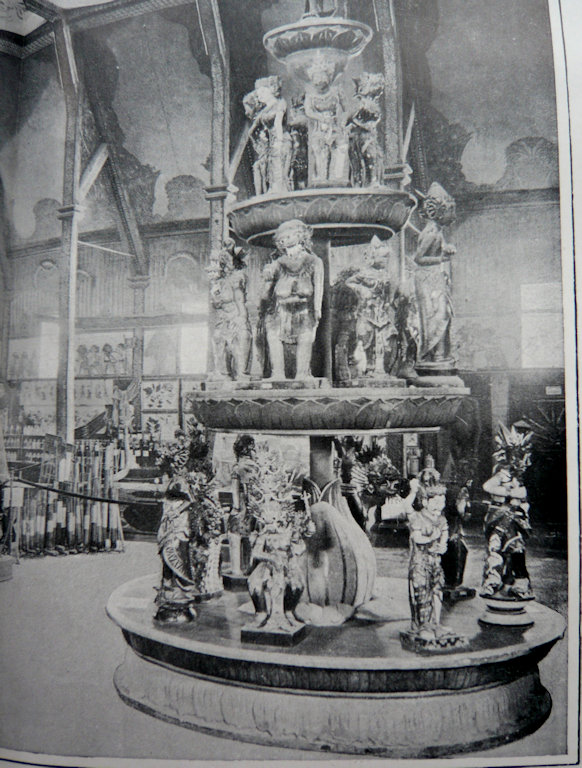
Lotus with statues of the Balinese Hindu Pantheon in wood, World Exhibition Paris 1900
The way in which they were grouped together is not in accordance with Balinese concepts of order and hierarchy.
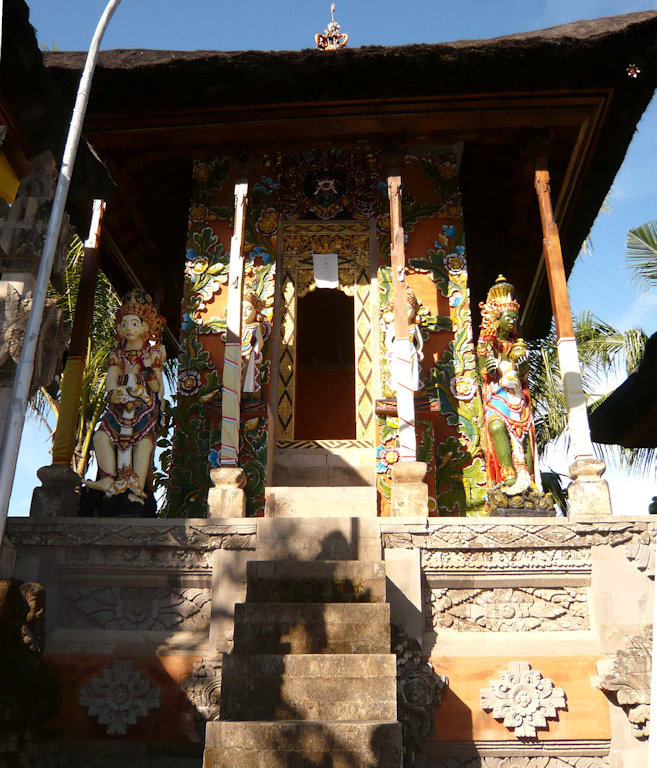
Pamrajan Gria Gede, Sawan with statues, left: Siwa Guru, right Wisnu
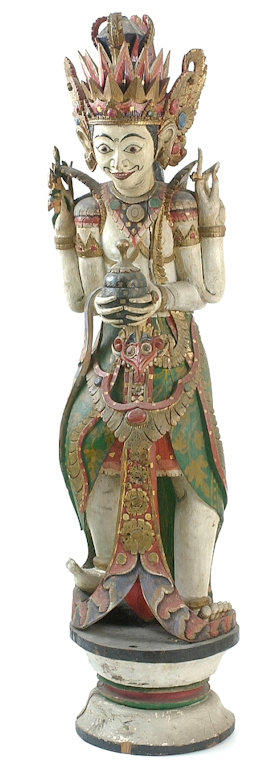
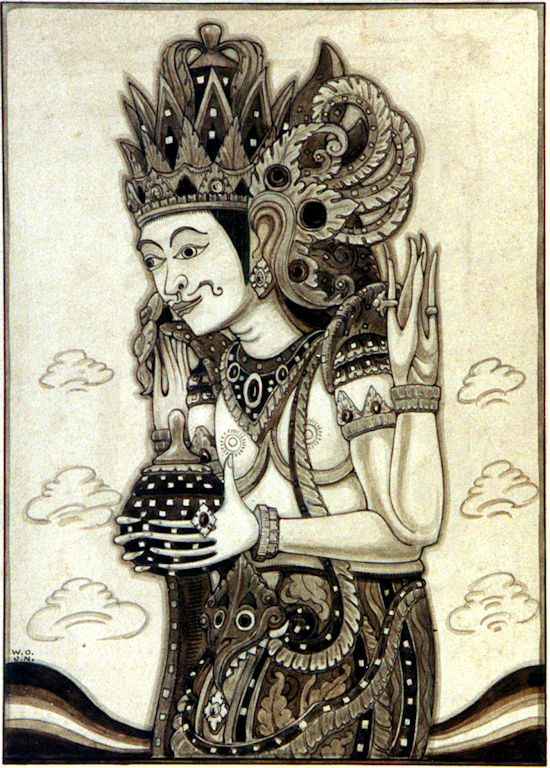
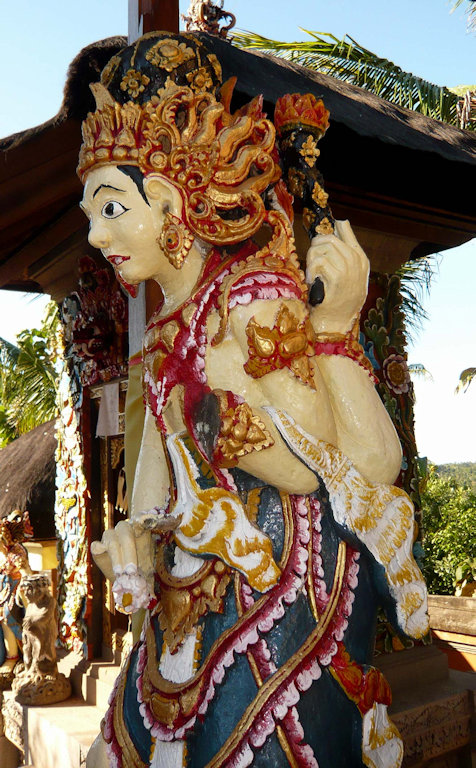
Batara Guru, KIT 14-158 drawing by Nieuwenkamp pamrajan G.Gede Sawan, re-painted
